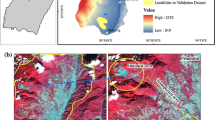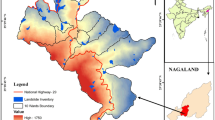Abstract
The aim of this study was to apply and to verify the use of fuzzy logic to landslide susceptibility mapping in the Gangneung area, Korea, using a geographic information system (GIS). For this aim, in the study, a data-derived model (frequency ratio) and a knowledge-derived model (fuzzy operator) were combined. Landslide locations were identified by changing the detection technique of KOMPSAT-1 images and checked by field studies. For landslide susceptibility mapping, maps of the topography, lineaments, soil, forest, and land cover were extracted from the spatial data sets, and the eight factors influencing landslide occurrence were obtained from the database. Using the factors and the identified landslide, the fuzzy membership values were calculated. Then fuzzy algebraic operators were applied to the fuzzy membership values for landslide susceptibility mapping. Finally, the produced map was verified by comparing with existing landslide locations for calculating prediction accuracy. Among the fuzzy operators, in the case in which the gamma operator (λ = 0.975) showed the best accuracy (84.68%) while the case in which the fuzzy or operator was applied showed the worst accuracy (66.50%).





Similar content being viewed by others
References
Atkinson PM, Massari R (1998) Generalized linear modeling of susceptibility to landsliding in the central Apennines, Italy. Comput Geosci 24:373–385
Baeza C, Corominas J (2001) Assessment of shallow landslide susceptibility by means of multivariate statistical techniques. Earth Surf Process Landforms 26:251–1263
Bonham-Carter GF (1994) Geographic information systems for geoscientists, modeling with GIS. Pergamon, Oxford, 398 pp
Carro M, De Amicis M, Luzi L, Marzorati S (2003) The application of predictive modeling techniques to landslides induced by earthquakes: the case study of the 26 September 1997 Umbria-Marche earthquake (Italy). Eng Geol 69:139–159
Clerici A, Perego S, Tellini C, Vescovi P (2002) A procedure for landslide susceptibility zonation by the conditional analysis method. Geomorphology 48:349–364
Dai FC, Lee CF (2002) Landslide characteristics and slope instability modeling using GIS, Lantau Island, Hong Kong. Geomorphology 42:213–228
Dai FC, Lee CF, Li J, Xu ZW (2001) Assessment of landslide susceptibility on the natural terrain of Lantau Island, Hong Kong. Environ Geol 40:381–391
Donati L, Turrini MC (2002) An objective method to rank the importance of the factors predisposing to landslides with the GIS methodology: application to an area of the Apennines (Valnerina; Perugia, Italy). Eng Geol 63:277–289
Ercanoglu M, Gokceoglu C (2002) Assessment of landslide susceptibility for a landslide-prone area (north of Yenice, NW Turkye) by fuzzy approach. Environ Geol 41:720–730
Ercanoglu M, Gokceoglu C (2004) Use of fuzzy relations to produce landslide susceptibility map of a landslide prone area (West Black Sea Region, Turkey). Eng Geol 75:229–250
Gokceoglu C, Sonmez H, Ercanoglu M (2000) Discontinuity controlled probabilistic slope failure risk maps of the Altindag (settlement) region in Turkey. Eng Geol 55:277–296
Guzzetti F, Carrarra A, Cardinali M, Reichenbach P (1999) Landslide hazard evaluation: a review of current techniques and their application in a multi-scale study. Central Italy. Geomorphology 31:181–216
Jibson RW, Harp EL, John AM (2000) A method for producing digital probabilistic seismic landslide hazard maps. Eng Geol 58:271–289
Lee S (2004) Application of likelihood ratio and logistic regression model for landslide susceptibility mapping using GIS. Environ Manage 34:223–232
Lee S, Choi U (2003) Development of GIS-based geological hazard information system and its application for landslide analysis in Korea. Geosci J 7:243–252
Lee S, Choi J (2004) Application of a weight-of-evidence model to landslide susceptibility analysis. Int J Geogr Inf Sci 18:789–814
Lee S, Min K (2001) Statistical analysis of landslide susceptibility at Yongin, Korea. Environ Geol 40:1095–1113
Lee S, Chwae U, Min K (2002a) Landslide susceptibility mapping by correlation between topography and geological structure: the Janghung area, Korea. Geomorphology 46:49–162
Lee S, Choi J, Min K (2002b) Landslide susceptibility analysis and verification using the Bayesian probability model. Environ Geol 43:120–131
Lee S, Ryu JH, Min KD, Won JS (2003a) Landslide susceptibility analysis using GIS and artificial neural network. Earth Surf Process Landforms 27:1361–1376
Lee S, Ryu JH, Lee MJ, Won JS (2003b) Landslide susceptibility analysis using artificial neural network at Boun, Korea. Environ Geol 44:820–833
Lee S, Ryu JH, Won JS, Park HJ (2004a) Determination and application of the weights for landslide susceptibility mapping using an artificial neural network. Eng Geol 71:289–302
Lee S, Choi J, Woo I (2004b) The effect of spatial resolution on the accuracy of landslide susceptibility mapping: a case study in Boun, Korea. Geosci J 8:51–60
Lee S, Choi J, Min K (2004c) Landslide hazard mapping using GIS and remote sensing data at Boun, Korea. Int J Remote Sens 25:2037–2052
Luzi L, Pergalani F, Terlien MTJ (2000) Slope vulnerability to earthquakes at subregional scale, using probabilistic techniques and geographic information systems. Eng Geol 58:313–336
Ohlmacher GC, Davis JC (2003) Using multiple logistic regression and GIS technology to predict landslide hazard in northeast Kansas, USA. Eng Geol 69:331–343
Parise M, Jibson RW (2000) A seismic landslide susceptibility rating of geologic units based on analysis of characteristics of landslides triggered by the 17 January, 1994 Northridge, California earthquake. Eng Geol 58:251–270
Pistocchi A, Luzi L, Napolitano P (2002) The use of predictive modeling techniques for optimal exploitation of spatial databases: a case study in landslide hazard mapping with expert system-like methods. Environ Geol 41:765–775
Refice A, Capolongo D (2002) Probabilistic modeling of uncertainties in earthquake-induced landslide hazard assessment. Comput Geosci 28:735–749
Romeo R (2000) Seismically induced landslide displacements: a predictive model. Eng Geol 58:337–351
Shou KJ, Wang CF (2003) Analysis of the Chiufengershan landslide triggered by the 1999 Chi-Chi earthquake in Taiwan. Eng Geol 68:237–250
Zadeh LA (1965) Fuzzy sets. IEEE Inf Control 8:338–353
Zhou CH, Lee CF, Li J, Xu ZW (2002) On the spatial relationship between landslides and causative factors on Lantau Island, Hong Kong. Geomorphology 43:197–207
Zhou G, Esaki T, Mitani Y, Xie M, Mori J (2003) Spatial probabilistic modeling of slope failure using an integrated GIS Monte Carlo simulation approach. Eng Geol 68:373–386
Zimmerman HJ (1996) Fuzzy set theory and it applications. Kluwer, Massachusetts, 435 pp
Acknowledgments
This research was supported by the Basic Research Project of the Korea Institute of Geoscience and Mineral Resources (KIGAM) funded by the Ministry of Science and Technology of Korea.
Author information
Authors and Affiliations
Corresponding author
Rights and permissions
About this article
Cite this article
Lee, S. Application and verification of fuzzy algebraic operators to landslide susceptibility mapping. Environ Geol 52, 615–623 (2007). https://doi.org/10.1007/s00254-006-0491-y
Received:
Accepted:
Published:
Issue Date:
DOI: https://doi.org/10.1007/s00254-006-0491-y




